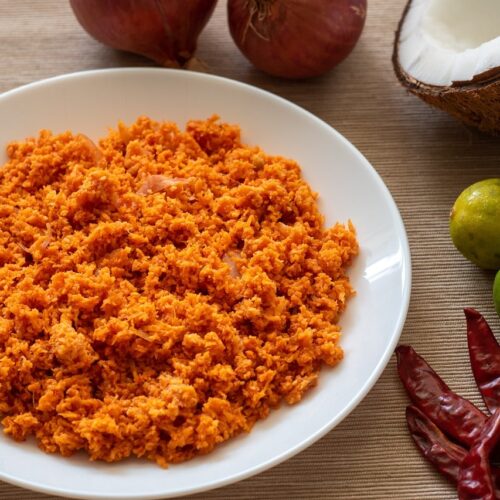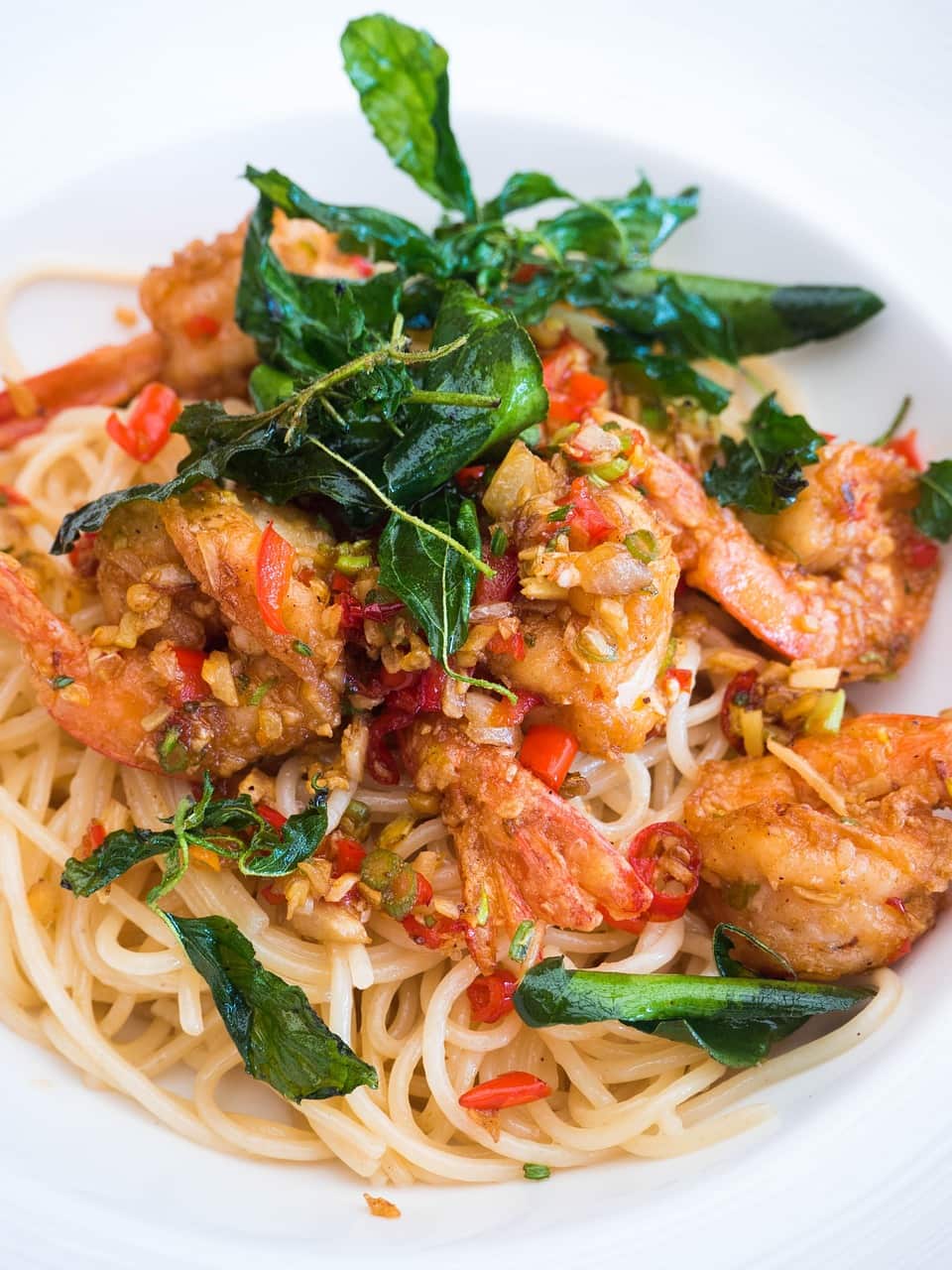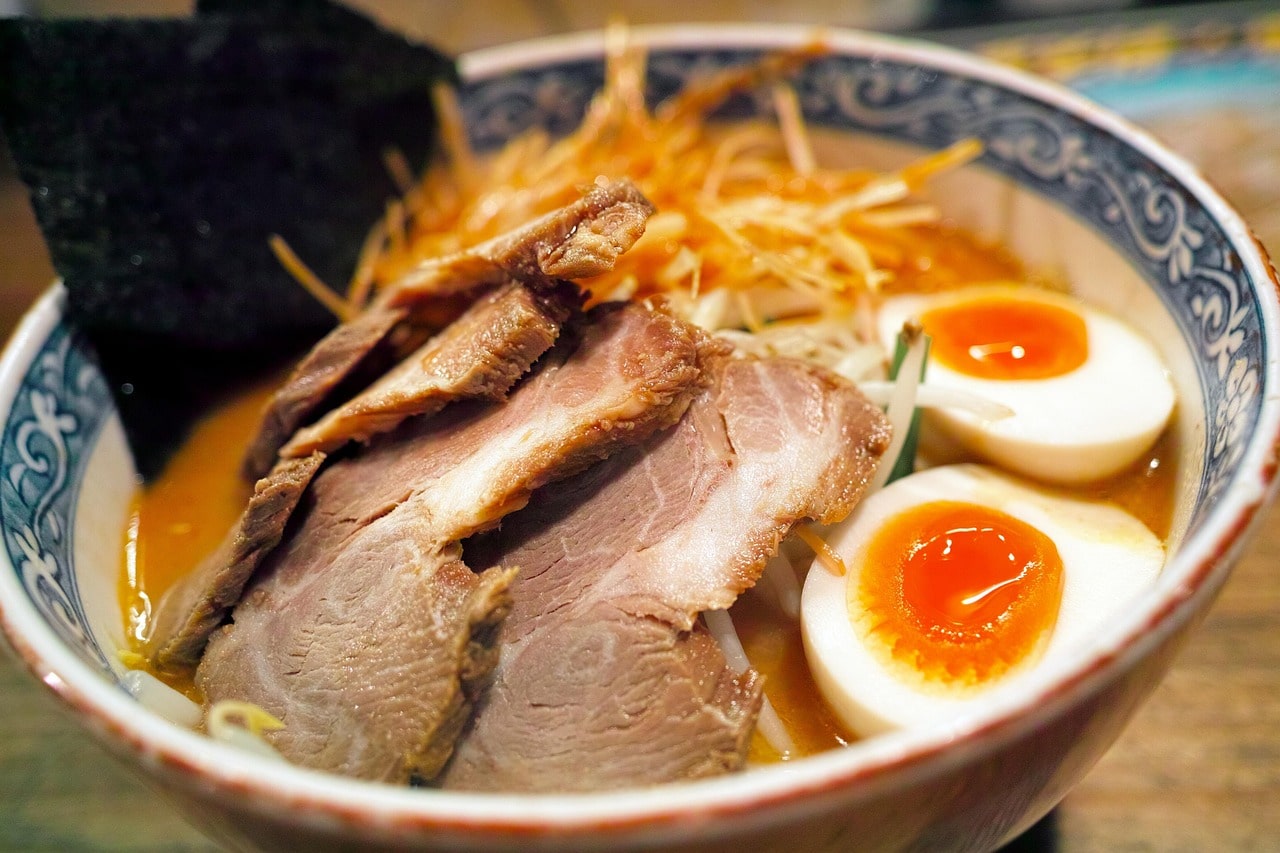A classic Sri Lankan side dish, pol sambola is cooked with freshly grated coconut, spices, and a hint of heat from the chilli pepper.
Ratings 05

A classic Sri Lankan side dish, pol sambola is cooked with freshly grated coconut, spices, and a hint of heat from the chilli pepper. This colorful condiment has the ideal mix of spicy, tangy, and savory flavors thanks to a combination of grated coconut, lime juice, salt, fresh chile, and occasionally onions. Pol Sambola is an adaptable side dish that tastes great with rice, roti, or string hoppers. It gives any meal a noticeable flavor boost. This coconut relish, which is simple yet incredibly flavorful, is a mainstay in Sri Lankan homes and is renowned for its freshness and capacity to improve even the most straightforward meals.
Greetings from our website, which serves as your go-to resource for learning about the vast and varied realm of Sri Lankan food. This website provides a selection of genuine recipes that encapsulate the spirit of traditional Sri Lankan cooking, suitable for both inexperienced and seasoned cooks. Every dish, from tasty vegetarian alternatives to delicate sweets and vivid sambols, is designed to bring the distinct taste of Sri Lanka into your home kitchen. Discover how to make delectable meals that will wow family and friends with our simple-to-follow instructions. Together, let’s prepare something very delicious!
What Is The Pol Sambola?
A classic Sri Lankan meal called pol sambola is cooked with freshly grated coconut and spices, chiles, lime juice, salt, and occasionally onions. It’s a tasty, straightforward condiment that gives food a tangy, spicy bite. The meal is well-known for its colorful flavor, which combines the cooling acidity of lime juice and the creamy texture of coconut to counterbalance the heat from the chilies.
A mainstay of Sri Lankan cooking, pol sambola is typically served as an accompaniment to rice, hoppers, string hoppers, or roti. It adds depth of flavor to even the most basic foods, making it a flexible side for both vegetarian and non-vegetarian meals. In addition to adding flavor, the fresh components in Pol Sambola promote immunity, assist with digestion, and increase metabolism, among other health advantages.
Easy to make, this dish is greatly appreciated in Sri Lankan homes for its ability to add flair to regular dinners with little work.
The Health Benefits Of Pol Sambola Are,
Pol Sambola is a healthy complement to meals since it provides several health advantages.
- Rich in Good Fats: One of the main ingredients in Pol Sambola is coconut, which has a high concentration of medium-chain triglycerides (MCTs). MCTs help speed up metabolism and provide energy quickly.
- High in Fiber: Pol Sambola’s shredded coconut is an excellent source of dietary fiber, which improves gut health, eases digestion, and prevents constipation.
- Rich in Antioxidants: Red chilies used in Pol Sambola contain capsaicin, an antioxidant with anti-inflammatory and metabolism-boosting qualities.
- Boosts Immunity: Lauric acid, which is found in coconuts, has antiviral, antibacterial, and antifungal qualities that support the immune system.
- Encourages Heart Health: When ingested in moderation, the heart-healthy fats included in coconuts may contribute to a rise in good HDL cholesterol.
- Helps with Detoxification: Another important component, lime juice, has a high vitamin C content and functions as a natural detoxifier by supporting liver health and assisting in the removal of toxins from the body.
- Low in Carbs: Pol Sambola is a low-carb food that may be consumed by those on ketogenic or low-carb diets.
Because Pol Sambola is made of nutrient-dense components, adding it to meals may improve flavor and have various health advantages.
Other Names Of The Pol Sambola,
Here are a few more names for Pol Sambola that correspond with its components or method of preparation:
- Coconut Sambal: Emphasizes the dish’s coconut foundation.
- Coconut Chili Relish: Brings out the natural heat of the chilies.
- Spicy Coconut Mix: Highlights the ingredients’ combination of spice and flavor.
- Coconut Chutney: This word describes the type of condiment, just like Indian chutneys do.
- Sri Lankan Coconut Relish: This dish emphasizes its location in Sri Lanka.
- Coconut and Lime Sambal: Highlights the zesty flavor of the lime.
- Coconut Chili Salsa: Adds a contemporary touch by drawing comparisons to salsa.
Depending on how you want to show or understand the meal, you can choose one of these titles.
Tips
- While frozen coconut works well in this recipe, fresh coconut has the greatest flavor. Shredded coconut may be found in any Asian grocery store’s freezer department in the United States. Ensure that you get “shredded” coconut rather than “chunks” of frozen coconut.
- Although it gives the Pol Sambola a spicy and garlicky flavor, adding a garlic clove to the recipe is entirely optional. If you’re not a lover of garlic, leave it out entirely.
- This recipe allows you to add a tiny tomato or a few cherry tomatoes. Tomatoes provide moisture and sourness to the pol sambol. If using tomatoes, use less lemon juice.
- Replace the red pearl onions with a quarter to a half of a standard red onion. It is not advised to use white onions in this recipe since they do not enhance the flavor of any sambola meal.
- Red chili flakes can be replaced with whole red chilies. Grind the entire red chilies in a mill and pestle after chopping them into smaller bits. Before grinding, take out the seeds to reduce the heat.
- Red chili powder can alternatively be used in place of the red chili flakes. Be aware that there will be some taste alterations.
- Without a pestle and mortar? Not a problem! Simply stir by hand all the ingredients. Since red chili powder is easier to blend than chili flakes in this situation, utilize it without a doubt.
- Umalakada, or maldive fish flakes, is a popular Sri Lankan condiment that adds umami flavor to pol sambol. If you are a vegetarian or vegan, please omit. Even without the maldive fish flakes, pol sambol is still delicious.
Serving & Storing
Served with rice or lentil sambal, this dish is a staple of any Sri Lankan breakfast, lunch, or supper. usually offered as a side dish with items like roti, rice, milk rice, string hoppers, and hoppers
However, this incredibly adaptable coconut relish isn’t only great with Sri Lankan cuisine—it also pairs nicely with bread, tortillas, naan, and chapati. Try it with sandwiches that have been toasted. You will adore it!
Any leftovers may be frozen for up to three months or stored in the refrigerator for up to a week in an airtight container.
FAQ
How Is Pol Sambola Constructed?
Freshly grated coconut, lime juice, salt, red or green chilies, and occasionally onions or Maldive fish (dried tuna) are the ingredients of Pol Sambola.
Is Pol Sambola A Vegan Or Vegetarian Dish?
Though it is occasionally included for flavor, Maldive fish can be left out to make Pol Sambola vegan.
How Hot Is The Pol Sambola Dish?
Because of the chilies used, Pol Sambola may be rather hot; however, the degree of heat can be changed by choosing milder kinds or lowering the amount of pepper.
Is It Possible To Store Pol Sambola?
Although fresh is preferable, pol sambola can be kept in the refrigerator for up to two days in an airtight container. Over time, the coconut’s freshness might deteriorate.
Which Foods Go Well With Pol Sambola?
Rice, hoppers, roti, and other traditional Sri Lankan foods like curries or dhal are frequently served with pol sambola.
Is There No Gluten In Pol Sambola?
Yes, because Pol Sambola is created with fresh ingredients, spices, and coconut, it is naturally gluten-free.
Can I Reduce The Spice Level Of Pol Sambola?
Yes, you may use milder chiles or use less chiles to make Pol Sambola less hot. To counteract the heat, you may also add more coconut.
Is There Any Gluten In Pol Sambola?
If Maldive fish is used in Pol Sambola, allergies can be present. If not, the ingredients should be okay, but always make sure there are no particular chile or coconut sensitivities.
Should You Serve Pol Sambola Hot Or Cold?
Traditionally, Pol Sambola is served cold or room temperature as a condiment or side dish.
How Can I Change The Pol Sambola’s Flavor?
You may change the flavor by adding additional onions for sweetness, adding more lime juice for tang, or adjusting the salt level. You can adjust the proportions of these components to suit your preferences.

Pol Sambola
Ingredients
- ½ shredded fresh coconut (about ½ pound/250 grams), or ½ pound/250 grams of frozen grated coconut
- Two teaspoons of crushed red pepper, or six tiny red dried chili peppers)
- ½ teaspoon salt
- 1 teaspoon sugar
- 6 small Bombay onions or 1 red onion, diced
- 1 tablespoon Maldive fish chips (optional)
- Juice of 1 lime
Instructions
- Grind the dried red chilies with the sugar and salt in a big mortar and pestle (or in smaller ones, working in stages) until the mixture is very fine and has no visible chili seeds.
- Next, include the optional Maldive fish chips and give it one more grind.
- The freshly shredded coconut should then be added to the mixture. At this point, the goal is for the coconut to take on the color and taste of the chile paste.
- Add the chopped red onions and mix finely. Continue grinding for a few more minutes to get a paste with a sufficient texture.
- After adding the lime juice and thoroughly mixing, serve.
-

BBQ Pork
-

Ravioli
-

Tofu
-

Spaghetti
-

Ramen
-

Tofu
-

Spaghetti
-

Ramen
-

Shrimp Scampi
-

Pad Thai

Leave a Comment